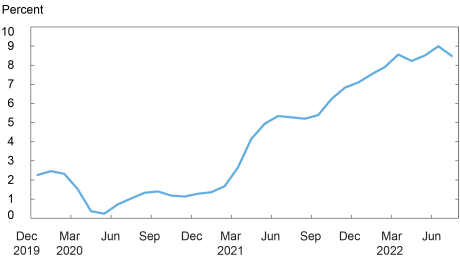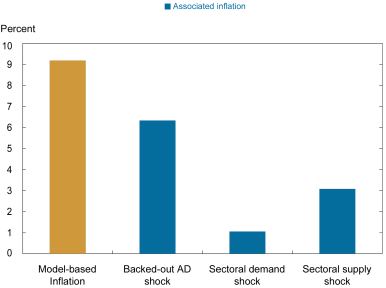
What elements are behind the latest inflation surge has been an enormous subject of debate amongst lecturers and policymakers. We all know that pandemic-related provide constraints akin to labor shortages and provide chain bottlenecks have been key elements pushing inflation greater. These bottlenecks began with the pandemic (lockdowns, sick employees) and have been made worse by the push arising from elevated demand attributable to very expansionary fiscal and financial coverage. Our evaluation of the relative significance of supply-side versus demand-side elements finds 60 p.c of U.S. inflation over the 2019-21 interval was because of the bounce in demand for items whereas 40 p.c owed to supply-side points that magnified the affect of this greater demand.
The Debate
The U.S. has witnessed close to historic inflation for the reason that financial system started to re-open in 2021 following the COVID-19 lockdowns, as seen within the chart beneath. There have been a number of elements put forth to elucidate this inflation outburst and its persistence, which have been tough for policymakers to disentangle and have led to an lively debate by main economists. Some analysts have targeted on the significance of provide chain constraints, whereas others level to demand as driving the bounce in inflation. In the meantime, some economists argue {that a} mixture of provide and demand elements are essential to generate the inflation we’re presently witnessing. Our work belongs to the final camp.
Inflation has been very elevated

Notes: This chart plots the patron worth index (CPI) for all city shoppers (all gadgets in U.S. metropolis common). The month-to-month sequence represents the share change from a 12 months in the past and isn’t seasonally adjusted.
A Mannequin-Primarily based Method
Arriving at a definitive understanding of the relative significance of demand and provide drivers of inflation is tough with out offering some formal construction that may be taken to the information. Within the latest work referenced above, we take a step on this course by constructing on the work of others to quantify the consequences of the pandemic on inflation over the interval spanning each the collapse and restoration phases of the financial system. This framework not solely permits us to look at the cumulative affect of the pandemic from 2019:This fall to 2021:This fall, earlier than the Russia-Ukraine warfare’s “power/meals shock” on inflation, but in addition to decompose the contribution of demand- and supply-side elements underlying the noticed inflation.
The mannequin permits for the noticed restricted issue mobility. That’s, since everybody was uncovered to the identical health-related shock at a world degree, it was tough for corporations to reallocate labor between sectors and/or change and substitute suppliers within the brief run, resulting in shortages in labor and in different inputs. Moreover, in addition to demand results being current on the mixture degree—because of accommodative fiscal and financial coverage—the composition of demand additionally modified as shoppers substituted from companies to items. The mannequin incorporates these mixture and sectoral demand results, which might additional amplify the affect of supply-side constraints on inflation because of the ensuing supply-demand imbalances.
Taking the Mannequin to the Information
We calibrate a closed-economy model of the mannequin to match the noticed U.S. inflation over the 2019-21 interval, together with doing an analogous train for the euro space. The mannequin implies that inflation is a operate of mixture demand shocks, modifications in hours labored, and productiveness by sector. The modifications in hours labored seize each demand and provide shocks, whereas modifications in productiveness/expertise are sectoral provide shocks.
We assume that sector-level technological modifications have been zero over the 2019-21 interval and use the noticed inflation fee together with sectoral hours labored to again out the implied mixture demand shock. The computed mixture demand shock captures a number of attainable demand drivers, akin to modifications in households’ preferences for consumption within the current vs. future in addition to expansionary results of fiscal and/or financial coverage.
Armed with the implied mixture demand shock, the expansion charges of sectoral hours labored, and the noticed change within the composition of sectoral consumption (that’s, a rise in consumption within the items sector and a fall in consumption within the service sector), we then use the mannequin construction to decompose the relative significance of provide and demand shocks in driving inflation. Crucially, the mannequin construction permits us to elucidate why noticed employment could have been beneath its “regular” degree, and what sectoral dimensions of the information are essential explaining this consequence—for instance, a scarcity of employees or an absence of demand given modifications in preferences and/or the combination demand shift
U.S. Outcomes
The primary bar within the chart beneath presents our estimation of the U.S. CPI inflation fee over the 2019-21 interval, which was calculated to be 9.18 p.c from December 2019 to December 2021, annualized. The precise noticed inflation throughout this era is 8.47 p.c, so the model-calibrated fee may be very shut. The subsequent three bars decompose the drivers of inflation. Discover that the sum of those bars is 10.5 p.c, which is barely greater given the nonlinear interactions between sixty-six sectors. The mixture demand shock (“backed-out AD shock”) explains roughly 60 p.c of model-based inflation. The remaining 40 p.c of the model-based inflation is primarily defined by sectoral provide shocks (“sectoral provide shock”), whereas the change in households’ consumption patterns throughout sectors (“sectoral demand shock”) accounts for little or no. The underside line of this decomposition is that provide constraints magnified the affect of upper demand in inflation. Consequently, most sectors within the U.S.—fifty-eight out of sixty-six—have been supply-constrained. This result’s in keeping with different analysis that reveals that expansionary fiscal coverage has elevated the share of sectors labeled as supply-constrained.
The mannequin calibration reveals the quantitative significance of each demand and provide shocks

Notes: The chart presents a U.S. closed-economy inflation decomposition for a sixty-six sector financial system, 2019-21. The primary bar reveals model-based inflation contemplating all shocks (demand and provide). The second bar considers the combination demand shift solely. The third bar makes use of sectoral demand shocks solely. Lastly, the fourth bar makes use of sectoral provide shocks solely.
Conclusions
The present debate on whether or not the Federal Reserve can engineer a tender touchdown must disentangle the drivers of U.S. inflation. Our work reveals that inflation within the U.S. would have been 6 p.c as a substitute of 9 p.c on the finish of 2021 with out provide bottlenecks. Our quantitative outcomes make clear why some pundits have been fallacious to foretell a transitory surge in inflation, whereas others have been proper in predicting excessive inflation, however for the fallacious causes. Put in another way, fiscal stimulus and different mixture demand elements wouldn’t have pushed inflation this excessive with out the pandemic-related provide constraints. Within the absence of any new power or different shock, it’s subsequently attainable that the continued easing of provide bottlenecks will trigger a considerable drop in inflation within the close to time period.

Julian di Giovanni is the pinnacle of Local weather Danger Research within the Federal Reserve Financial institution of New York’s Analysis and Statistics Group.
Learn how to cite this submit:
Julian di Giovanni, “How A lot Did Provide Constraints Enhance U.S. Inflation?,” Federal Reserve Financial institution of New York Liberty Road Economics, August 24, 2022, https://libertystreeteconomics.newyorkfed.org/2022/08/how-much-did-supply-constraints-boost-u-s-inflation/.
Disclaimer
The views expressed on this submit are these of the creator(s) and don’t essentially mirror the place of the Federal Reserve Financial institution of New York or the Federal Reserve System. Any errors or omissions are the duty of the creator(s).

